The Science of Sustainability: Life Cycle Assessment of Energy Systems
VerifiedAdded on 2022/08/29
|19
|3903
|16
Case Study
AI Summary
This case study analyzes the life cycle assessment (LCA) of solar and coal power generation systems, essential tools for future sustainable business managers. The study begins by defining the scope and goals, comparing the life cycles of solar and coal plants. It then explores the inventory analysis phase, detailing material and energy flows, and uses the Eco invent database for data collection. The impact assessment phase employs the ILCD method to evaluate environmental effects, considering factors like climate change and resource depletion. The study compares the environmental impacts of each system, with solar-PV and coal-fired power generation. The raw material flows (RMF) procedure and cumulative energy demand (CED) tactic are applied to assess inputs and outputs. The interpretation phase evaluates and measures the key environmental impacts. The study finds that the greatest impact of solar-PV is on climate change, ozone reduction, human toxicity, photochemical ozone depletion, acidification, marine eutrophication and water resource depletion. For the battery, the greatest impacts are on mineral, fossil and depletion of renewable resource, use of land and eutrophication of freshwater. The results highlight the importance of considering the entire life cycle when evaluating the environmental performance of energy systems.
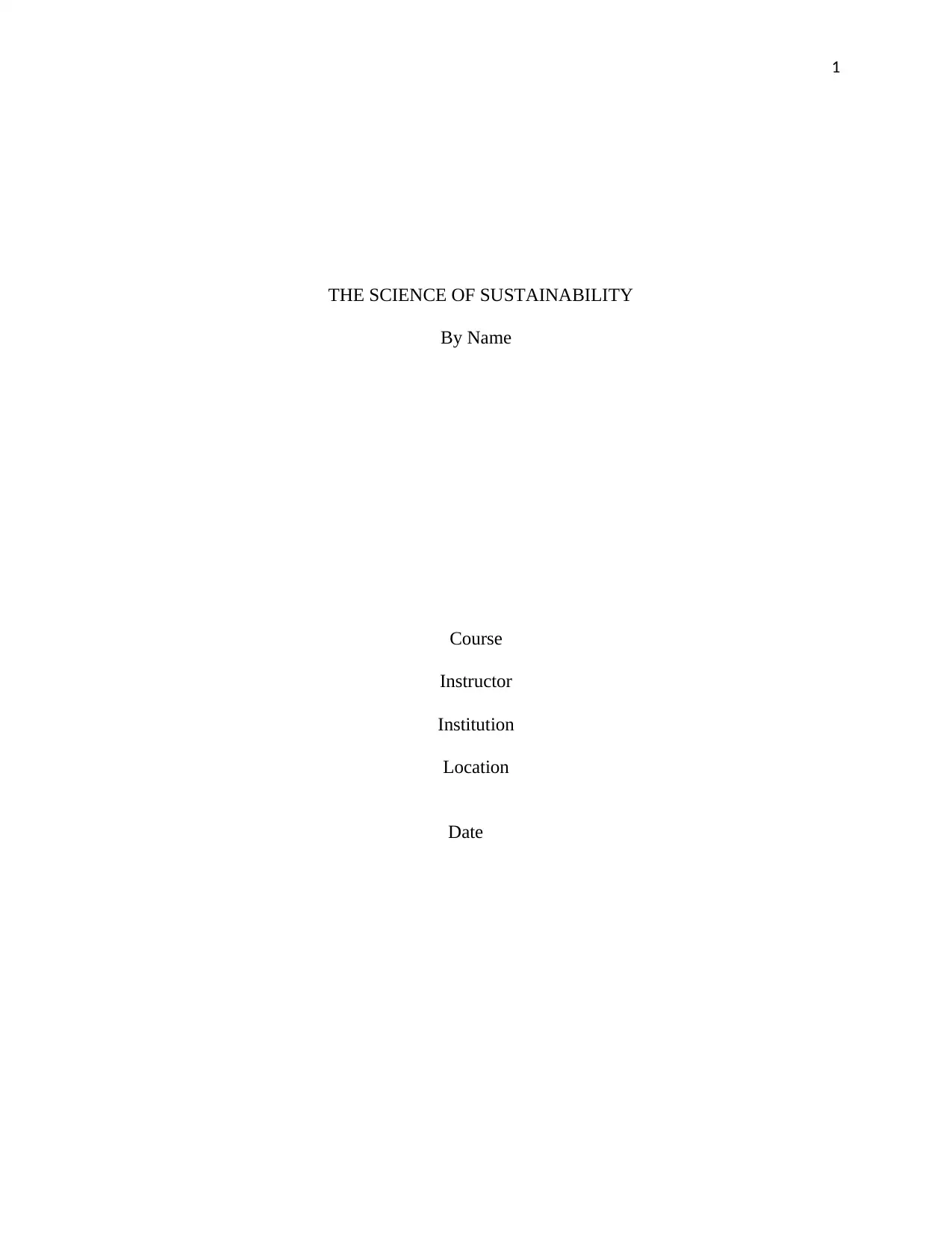
1
THE SCIENCE OF SUSTAINABILITY
By Name
Course
Instructor
Institution
Location
Date
THE SCIENCE OF SUSTAINABILITY
By Name
Course
Instructor
Institution
Location
Date
Paraphrase This Document
Need a fresh take? Get an instant paraphrase of this document with our AI Paraphraser
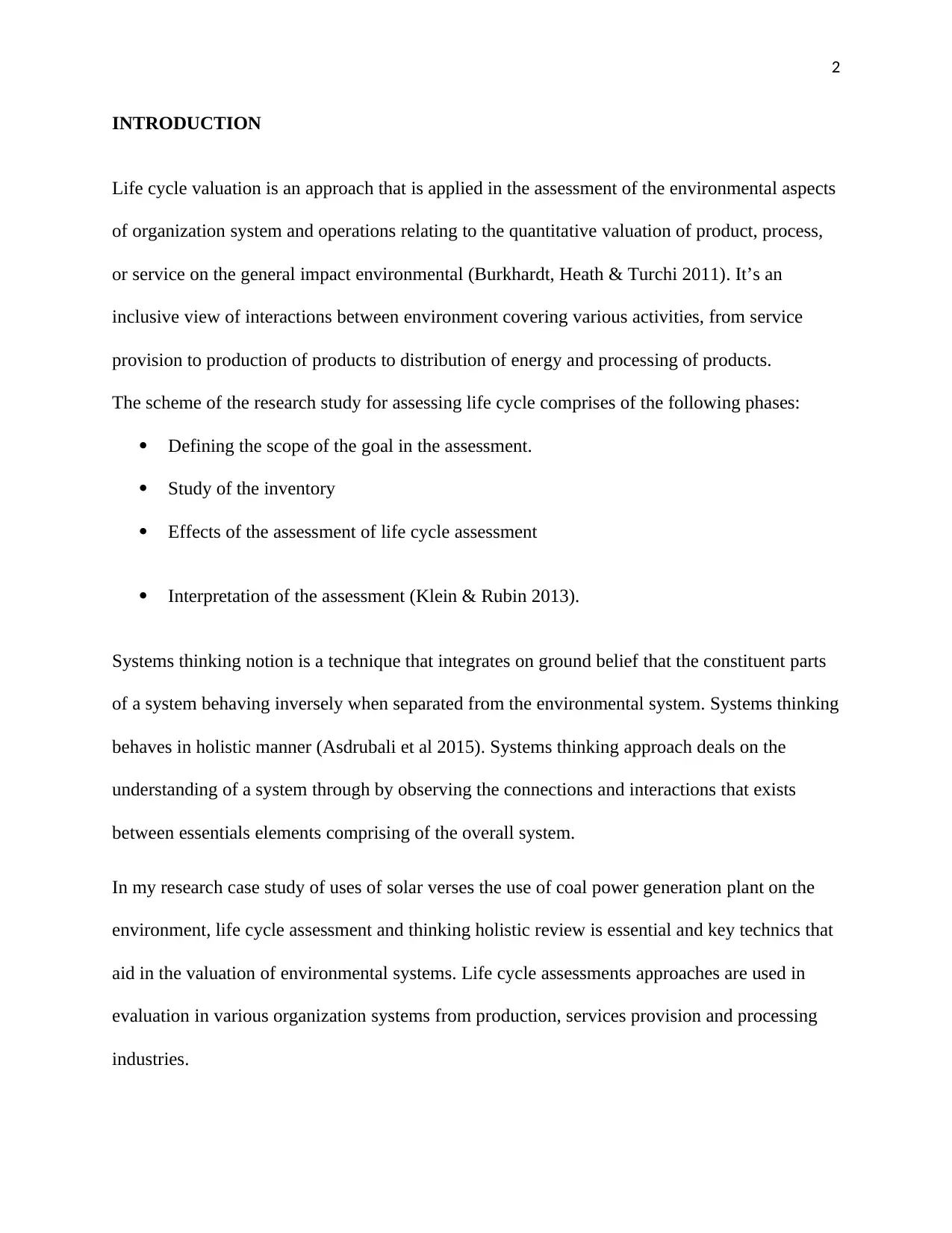
2
INTRODUCTION
Life cycle valuation is an approach that is applied in the assessment of the environmental aspects
of organization system and operations relating to the quantitative valuation of product, process,
or service on the general impact environmental (Burkhardt, Heath & Turchi 2011). It’s an
inclusive view of interactions between environment covering various activities, from service
provision to production of products to distribution of energy and processing of products.
The scheme of the research study for assessing life cycle comprises of the following phases:
Defining the scope of the goal in the assessment.
Study of the inventory
Effects of the assessment of life cycle assessment
Interpretation of the assessment (Klein & Rubin 2013).
Systems thinking notion is a technique that integrates on ground belief that the constituent parts
of a system behaving inversely when separated from the environmental system. Systems thinking
behaves in holistic manner (Asdrubali et al 2015). Systems thinking approach deals on the
understanding of a system through by observing the connections and interactions that exists
between essentials elements comprising of the overall system.
In my research case study of uses of solar verses the use of coal power generation plant on the
environment, life cycle assessment and thinking holistic review is essential and key technics that
aid in the valuation of environmental systems. Life cycle assessments approaches are used in
evaluation in various organization systems from production, services provision and processing
industries.
INTRODUCTION
Life cycle valuation is an approach that is applied in the assessment of the environmental aspects
of organization system and operations relating to the quantitative valuation of product, process,
or service on the general impact environmental (Burkhardt, Heath & Turchi 2011). It’s an
inclusive view of interactions between environment covering various activities, from service
provision to production of products to distribution of energy and processing of products.
The scheme of the research study for assessing life cycle comprises of the following phases:
Defining the scope of the goal in the assessment.
Study of the inventory
Effects of the assessment of life cycle assessment
Interpretation of the assessment (Klein & Rubin 2013).
Systems thinking notion is a technique that integrates on ground belief that the constituent parts
of a system behaving inversely when separated from the environmental system. Systems thinking
behaves in holistic manner (Asdrubali et al 2015). Systems thinking approach deals on the
understanding of a system through by observing the connections and interactions that exists
between essentials elements comprising of the overall system.
In my research case study of uses of solar verses the use of coal power generation plant on the
environment, life cycle assessment and thinking holistic review is essential and key technics that
aid in the valuation of environmental systems. Life cycle assessments approaches are used in
evaluation in various organization systems from production, services provision and processing
industries.
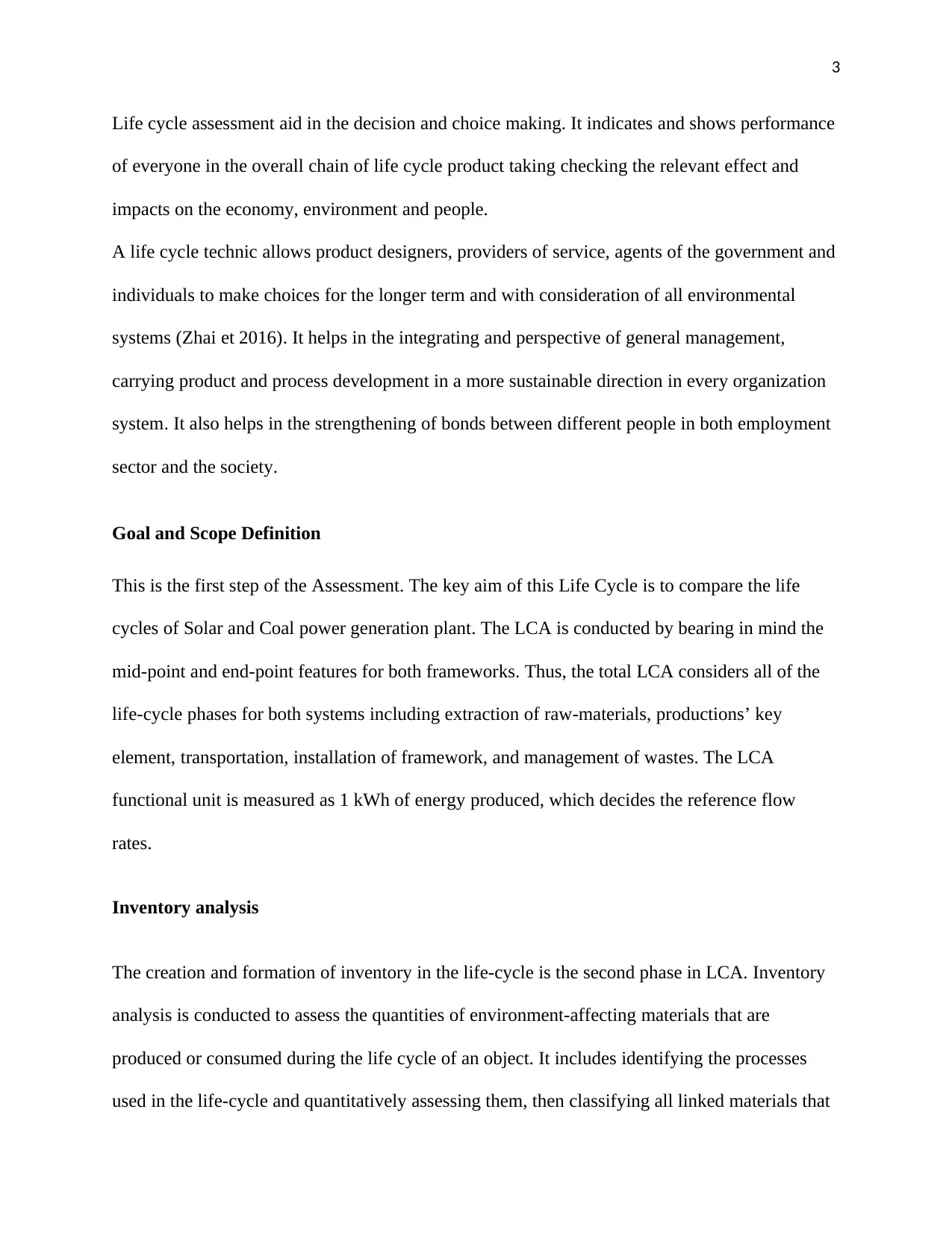
3
Life cycle assessment aid in the decision and choice making. It indicates and shows performance
of everyone in the overall chain of life cycle product taking checking the relevant effect and
impacts on the economy, environment and people.
A life cycle technic allows product designers, providers of service, agents of the government and
individuals to make choices for the longer term and with consideration of all environmental
systems (Zhai et 2016). It helps in the integrating and perspective of general management,
carrying product and process development in a more sustainable direction in every organization
system. It also helps in the strengthening of bonds between different people in both employment
sector and the society.
Goal and Scope Definition
This is the first step of the Assessment. The key aim of this Life Cycle is to compare the life
cycles of Solar and Coal power generation plant. The LCA is conducted by bearing in mind the
mid-point and end-point features for both frameworks. Thus, the total LCA considers all of the
life-cycle phases for both systems including extraction of raw-materials, productions’ key
element, transportation, installation of framework, and management of wastes. The LCA
functional unit is measured as 1 kWh of energy produced, which decides the reference flow
rates.
Inventory analysis
The creation and formation of inventory in the life-cycle is the second phase in LCA. Inventory
analysis is conducted to assess the quantities of environment-affecting materials that are
produced or consumed during the life cycle of an object. It includes identifying the processes
used in the life-cycle and quantitatively assessing them, then classifying all linked materials that
Life cycle assessment aid in the decision and choice making. It indicates and shows performance
of everyone in the overall chain of life cycle product taking checking the relevant effect and
impacts on the economy, environment and people.
A life cycle technic allows product designers, providers of service, agents of the government and
individuals to make choices for the longer term and with consideration of all environmental
systems (Zhai et 2016). It helps in the integrating and perspective of general management,
carrying product and process development in a more sustainable direction in every organization
system. It also helps in the strengthening of bonds between different people in both employment
sector and the society.
Goal and Scope Definition
This is the first step of the Assessment. The key aim of this Life Cycle is to compare the life
cycles of Solar and Coal power generation plant. The LCA is conducted by bearing in mind the
mid-point and end-point features for both frameworks. Thus, the total LCA considers all of the
life-cycle phases for both systems including extraction of raw-materials, productions’ key
element, transportation, installation of framework, and management of wastes. The LCA
functional unit is measured as 1 kWh of energy produced, which decides the reference flow
rates.
Inventory analysis
The creation and formation of inventory in the life-cycle is the second phase in LCA. Inventory
analysis is conducted to assess the quantities of environment-affecting materials that are
produced or consumed during the life cycle of an object. It includes identifying the processes
used in the life-cycle and quantitatively assessing them, then classifying all linked materials that
⊘ This is a preview!⊘
Do you want full access?
Subscribe today to unlock all pages.

Trusted by 1+ million students worldwide
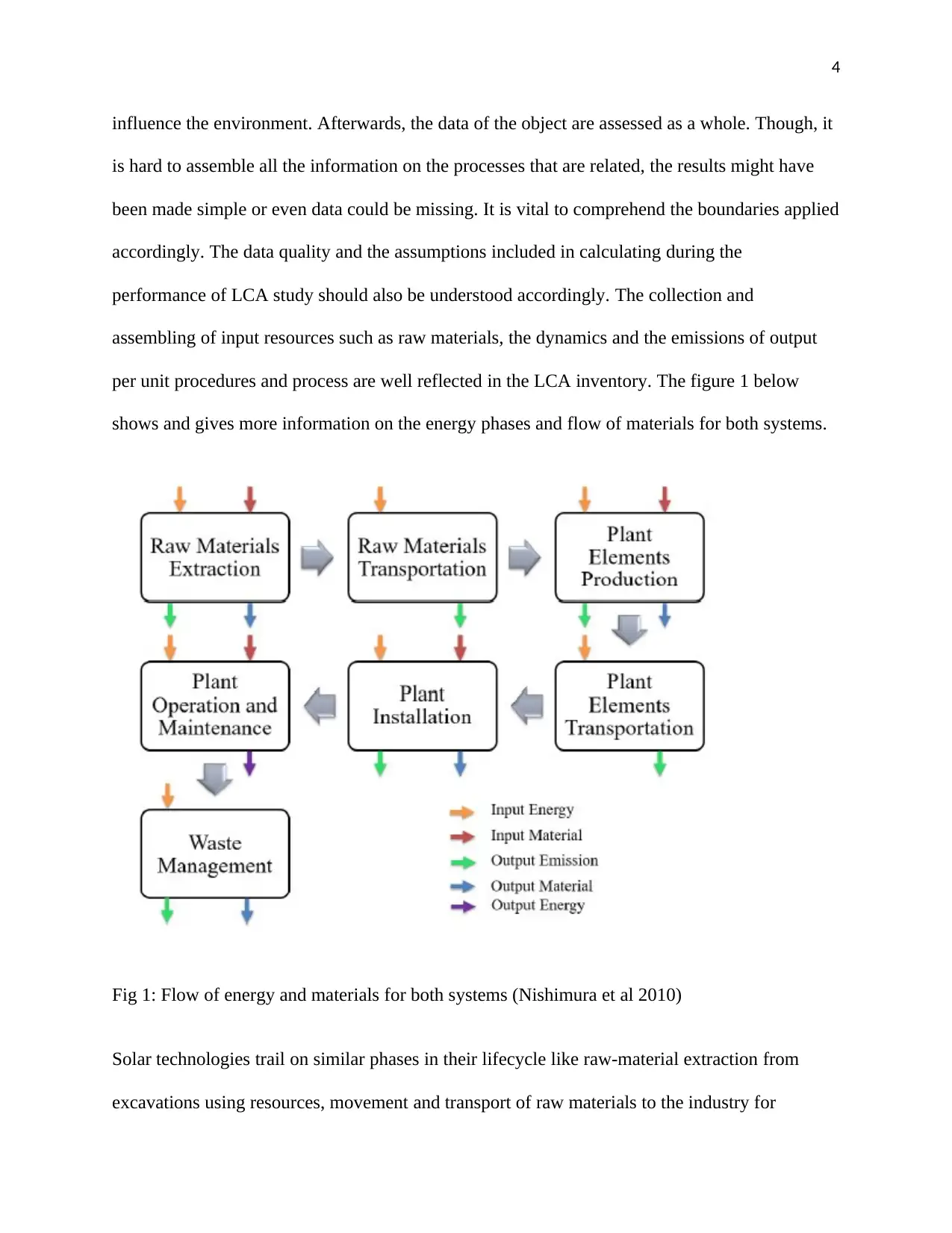
4
influence the environment. Afterwards, the data of the object are assessed as a whole. Though, it
is hard to assemble all the information on the processes that are related, the results might have
been made simple or even data could be missing. It is vital to comprehend the boundaries applied
accordingly. The data quality and the assumptions included in calculating during the
performance of LCA study should also be understood accordingly. The collection and
assembling of input resources such as raw materials, the dynamics and the emissions of output
per unit procedures and process are well reflected in the LCA inventory. The figure 1 below
shows and gives more information on the energy phases and flow of materials for both systems.
Fig 1: Flow of energy and materials for both systems (Nishimura et al 2010)
Solar technologies trail on similar phases in their lifecycle like raw-material extraction from
excavations using resources, movement and transport of raw materials to the industry for
influence the environment. Afterwards, the data of the object are assessed as a whole. Though, it
is hard to assemble all the information on the processes that are related, the results might have
been made simple or even data could be missing. It is vital to comprehend the boundaries applied
accordingly. The data quality and the assumptions included in calculating during the
performance of LCA study should also be understood accordingly. The collection and
assembling of input resources such as raw materials, the dynamics and the emissions of output
per unit procedures and process are well reflected in the LCA inventory. The figure 1 below
shows and gives more information on the energy phases and flow of materials for both systems.
Fig 1: Flow of energy and materials for both systems (Nishimura et al 2010)
Solar technologies trail on similar phases in their lifecycle like raw-material extraction from
excavations using resources, movement and transport of raw materials to the industry for
Paraphrase This Document
Need a fresh take? Get an instant paraphrase of this document with our AI Paraphraser
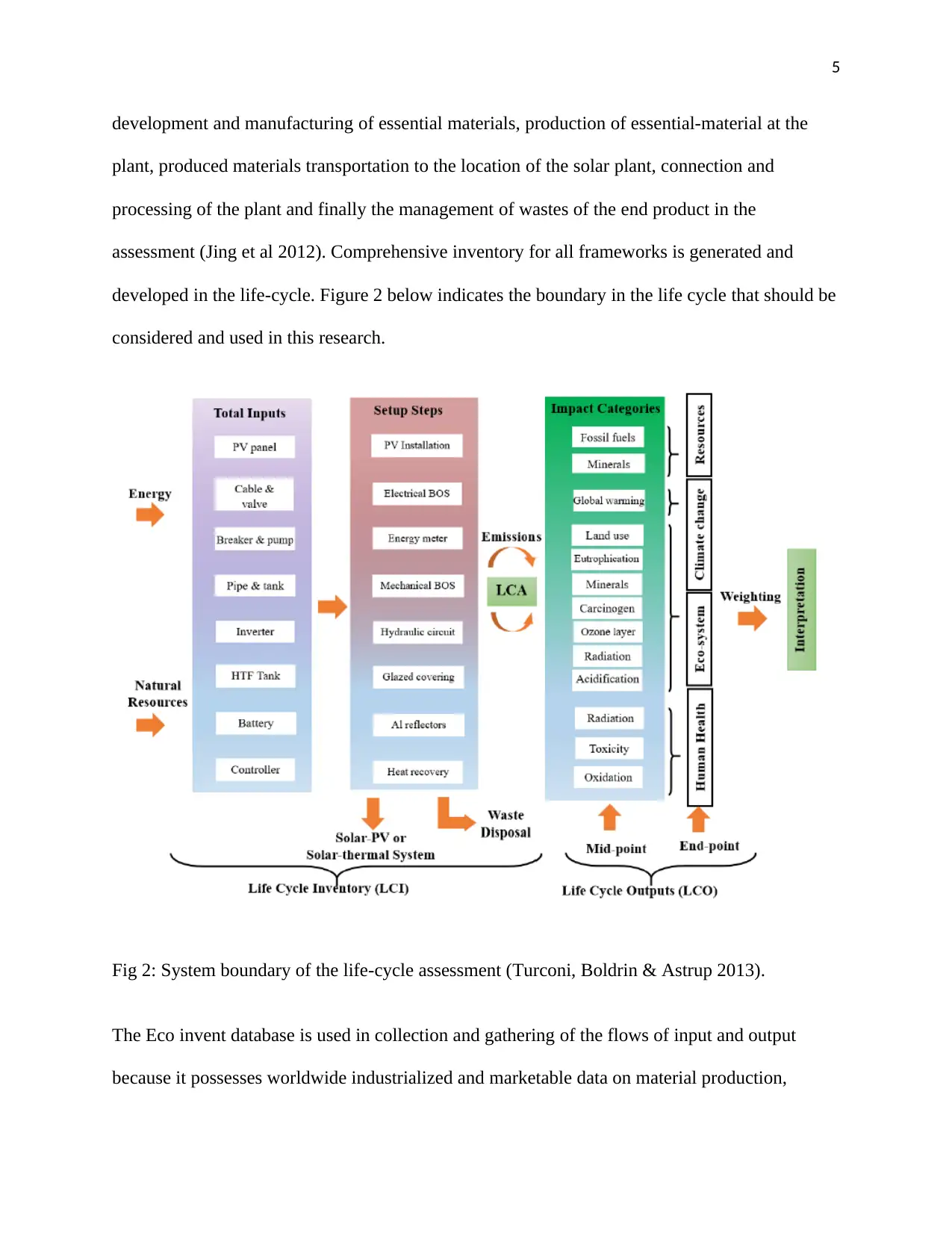
5
development and manufacturing of essential materials, production of essential-material at the
plant, produced materials transportation to the location of the solar plant, connection and
processing of the plant and finally the management of wastes of the end product in the
assessment (Jing et al 2012). Comprehensive inventory for all frameworks is generated and
developed in the life-cycle. Figure 2 below indicates the boundary in the life cycle that should be
considered and used in this research.
Fig 2: System boundary of the life-cycle assessment (Turconi, Boldrin & Astrup 2013).
The Eco invent database is used in collection and gathering of the flows of input and output
because it possesses worldwide industrialized and marketable data on material production,
development and manufacturing of essential materials, production of essential-material at the
plant, produced materials transportation to the location of the solar plant, connection and
processing of the plant and finally the management of wastes of the end product in the
assessment (Jing et al 2012). Comprehensive inventory for all frameworks is generated and
developed in the life-cycle. Figure 2 below indicates the boundary in the life cycle that should be
considered and used in this research.
Fig 2: System boundary of the life-cycle assessment (Turconi, Boldrin & Astrup 2013).
The Eco invent database is used in collection and gathering of the flows of input and output
because it possesses worldwide industrialized and marketable data on material production,
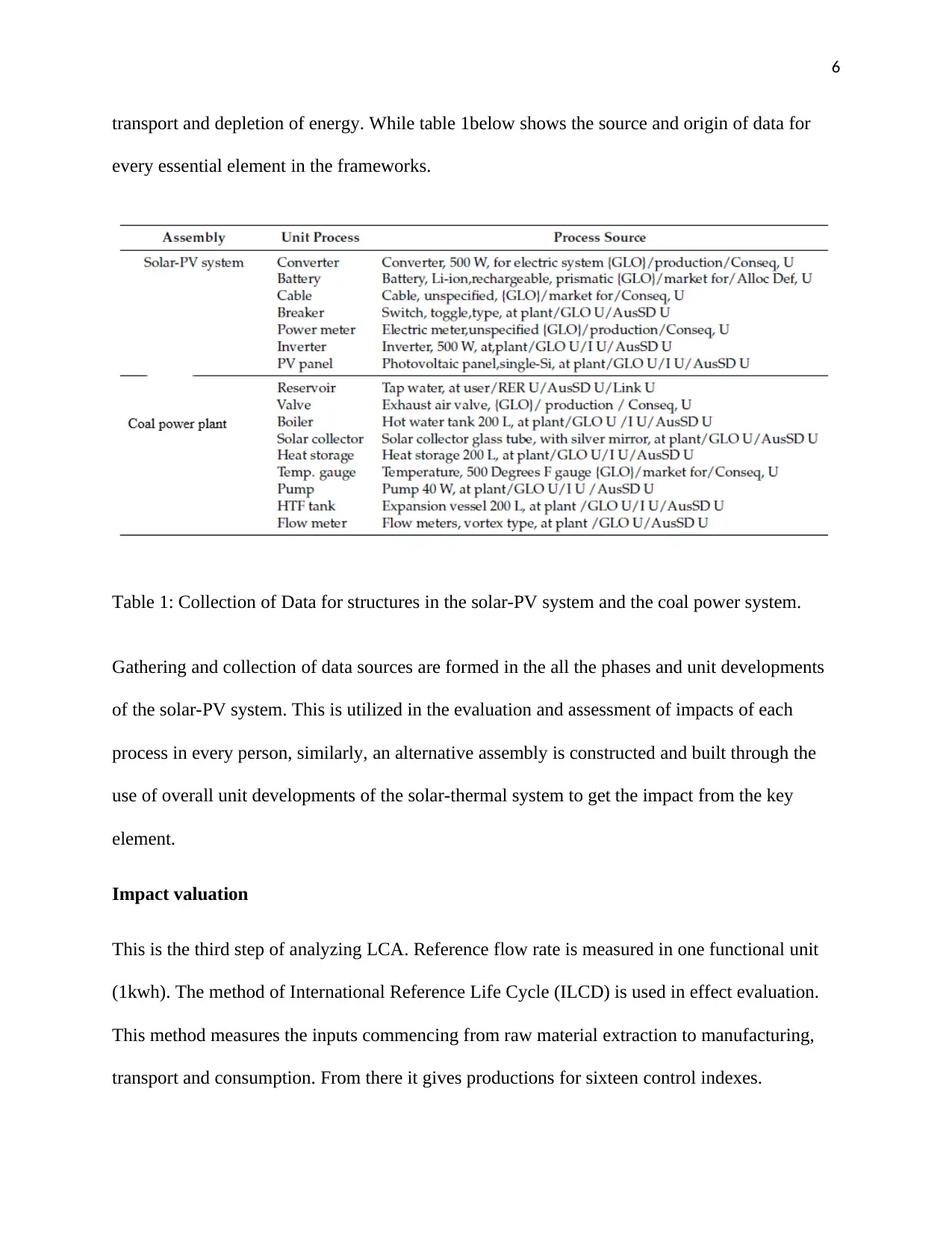
6
transport and depletion of energy. While table 1below shows the source and origin of data for
every essential element in the frameworks.
Table 1: Collection of Data for structures in the solar-PV system and the coal power system.
Gathering and collection of data sources are formed in the all the phases and unit developments
of the solar-PV system. This is utilized in the evaluation and assessment of impacts of each
process in every person, similarly, an alternative assembly is constructed and built through the
use of overall unit developments of the solar-thermal system to get the impact from the key
element.
Impact valuation
This is the third step of analyzing LCA. Reference flow rate is measured in one functional unit
(1kwh). The method of International Reference Life Cycle (ILCD) is used in effect evaluation.
This method measures the inputs commencing from raw material extraction to manufacturing,
transport and consumption. From there it gives productions for sixteen control indexes.
transport and depletion of energy. While table 1below shows the source and origin of data for
every essential element in the frameworks.
Table 1: Collection of Data for structures in the solar-PV system and the coal power system.
Gathering and collection of data sources are formed in the all the phases and unit developments
of the solar-PV system. This is utilized in the evaluation and assessment of impacts of each
process in every person, similarly, an alternative assembly is constructed and built through the
use of overall unit developments of the solar-thermal system to get the impact from the key
element.
Impact valuation
This is the third step of analyzing LCA. Reference flow rate is measured in one functional unit
(1kwh). The method of International Reference Life Cycle (ILCD) is used in effect evaluation.
This method measures the inputs commencing from raw material extraction to manufacturing,
transport and consumption. From there it gives productions for sixteen control indexes.
⊘ This is a preview!⊘
Do you want full access?
Subscribe today to unlock all pages.

Trusted by 1+ million students worldwide
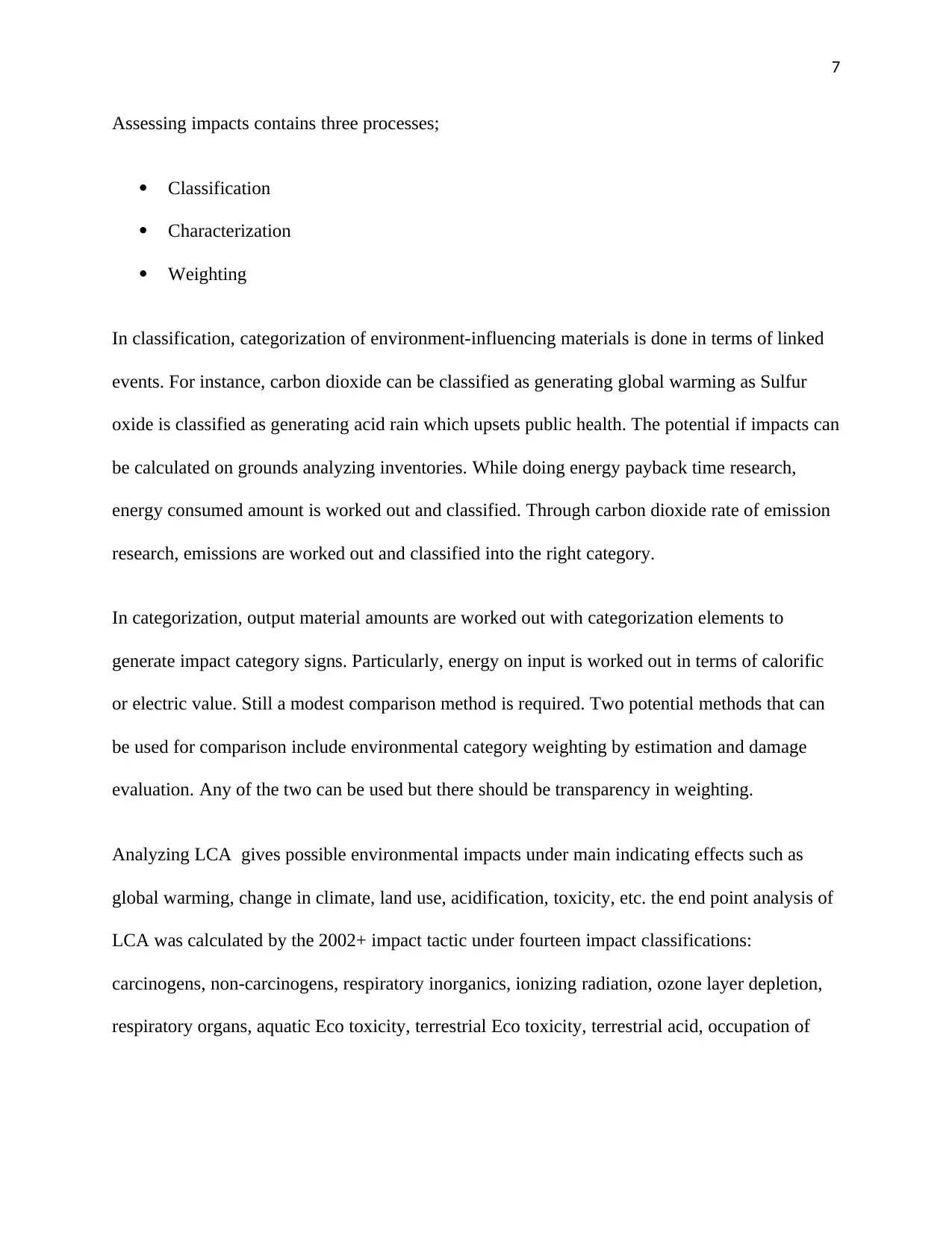
7
Assessing impacts contains three processes;
Classification
Characterization
Weighting
In classification, categorization of environment-influencing materials is done in terms of linked
events. For instance, carbon dioxide can be classified as generating global warming as Sulfur
oxide is classified as generating acid rain which upsets public health. The potential if impacts can
be calculated on grounds analyzing inventories. While doing energy payback time research,
energy consumed amount is worked out and classified. Through carbon dioxide rate of emission
research, emissions are worked out and classified into the right category.
In categorization, output material amounts are worked out with categorization elements to
generate impact category signs. Particularly, energy on input is worked out in terms of calorific
or electric value. Still a modest comparison method is required. Two potential methods that can
be used for comparison include environmental category weighting by estimation and damage
evaluation. Any of the two can be used but there should be transparency in weighting.
Analyzing LCA gives possible environmental impacts under main indicating effects such as
global warming, change in climate, land use, acidification, toxicity, etc. the end point analysis of
LCA was calculated by the 2002+ impact tactic under fourteen impact classifications:
carcinogens, non-carcinogens, respiratory inorganics, ionizing radiation, ozone layer depletion,
respiratory organs, aquatic Eco toxicity, terrestrial Eco toxicity, terrestrial acid, occupation of
Assessing impacts contains three processes;
Classification
Characterization
Weighting
In classification, categorization of environment-influencing materials is done in terms of linked
events. For instance, carbon dioxide can be classified as generating global warming as Sulfur
oxide is classified as generating acid rain which upsets public health. The potential if impacts can
be calculated on grounds analyzing inventories. While doing energy payback time research,
energy consumed amount is worked out and classified. Through carbon dioxide rate of emission
research, emissions are worked out and classified into the right category.
In categorization, output material amounts are worked out with categorization elements to
generate impact category signs. Particularly, energy on input is worked out in terms of calorific
or electric value. Still a modest comparison method is required. Two potential methods that can
be used for comparison include environmental category weighting by estimation and damage
evaluation. Any of the two can be used but there should be transparency in weighting.
Analyzing LCA gives possible environmental impacts under main indicating effects such as
global warming, change in climate, land use, acidification, toxicity, etc. the end point analysis of
LCA was calculated by the 2002+ impact tactic under fourteen impact classifications:
carcinogens, non-carcinogens, respiratory inorganics, ionizing radiation, ozone layer depletion,
respiratory organs, aquatic Eco toxicity, terrestrial Eco toxicity, terrestrial acid, occupation of
Paraphrase This Document
Need a fresh take? Get an instant paraphrase of this document with our AI Paraphraser
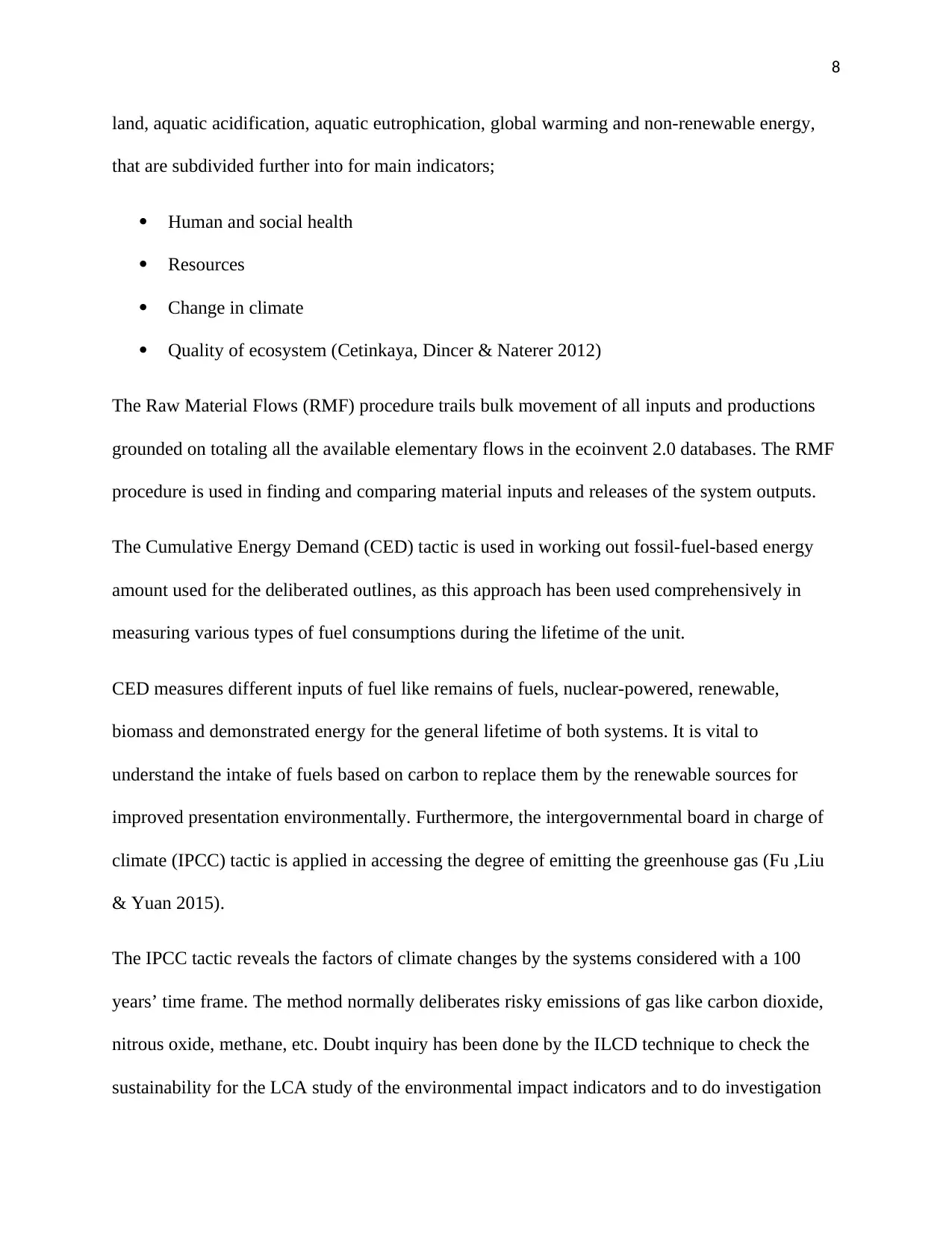
8
land, aquatic acidification, aquatic eutrophication, global warming and non-renewable energy,
that are subdivided further into for main indicators;
Human and social health
Resources
Change in climate
Quality of ecosystem (Cetinkaya, Dincer & Naterer 2012)
The Raw Material Flows (RMF) procedure trails bulk movement of all inputs and productions
grounded on totaling all the available elementary flows in the ecoinvent 2.0 databases. The RMF
procedure is used in finding and comparing material inputs and releases of the system outputs.
The Cumulative Energy Demand (CED) tactic is used in working out fossil-fuel-based energy
amount used for the deliberated outlines, as this approach has been used comprehensively in
measuring various types of fuel consumptions during the lifetime of the unit.
CED measures different inputs of fuel like remains of fuels, nuclear-powered, renewable,
biomass and demonstrated energy for the general lifetime of both systems. It is vital to
understand the intake of fuels based on carbon to replace them by the renewable sources for
improved presentation environmentally. Furthermore, the intergovernmental board in charge of
climate (IPCC) tactic is applied in accessing the degree of emitting the greenhouse gas (Fu ,Liu
& Yuan 2015).
The IPCC tactic reveals the factors of climate changes by the systems considered with a 100
years’ time frame. The method normally deliberates risky emissions of gas like carbon dioxide,
nitrous oxide, methane, etc. Doubt inquiry has been done by the ILCD technique to check the
sustainability for the LCA study of the environmental impact indicators and to do investigation
land, aquatic acidification, aquatic eutrophication, global warming and non-renewable energy,
that are subdivided further into for main indicators;
Human and social health
Resources
Change in climate
Quality of ecosystem (Cetinkaya, Dincer & Naterer 2012)
The Raw Material Flows (RMF) procedure trails bulk movement of all inputs and productions
grounded on totaling all the available elementary flows in the ecoinvent 2.0 databases. The RMF
procedure is used in finding and comparing material inputs and releases of the system outputs.
The Cumulative Energy Demand (CED) tactic is used in working out fossil-fuel-based energy
amount used for the deliberated outlines, as this approach has been used comprehensively in
measuring various types of fuel consumptions during the lifetime of the unit.
CED measures different inputs of fuel like remains of fuels, nuclear-powered, renewable,
biomass and demonstrated energy for the general lifetime of both systems. It is vital to
understand the intake of fuels based on carbon to replace them by the renewable sources for
improved presentation environmentally. Furthermore, the intergovernmental board in charge of
climate (IPCC) tactic is applied in accessing the degree of emitting the greenhouse gas (Fu ,Liu
& Yuan 2015).
The IPCC tactic reveals the factors of climate changes by the systems considered with a 100
years’ time frame. The method normally deliberates risky emissions of gas like carbon dioxide,
nitrous oxide, methane, etc. Doubt inquiry has been done by the ILCD technique to check the
sustainability for the LCA study of the environmental impact indicators and to do investigation
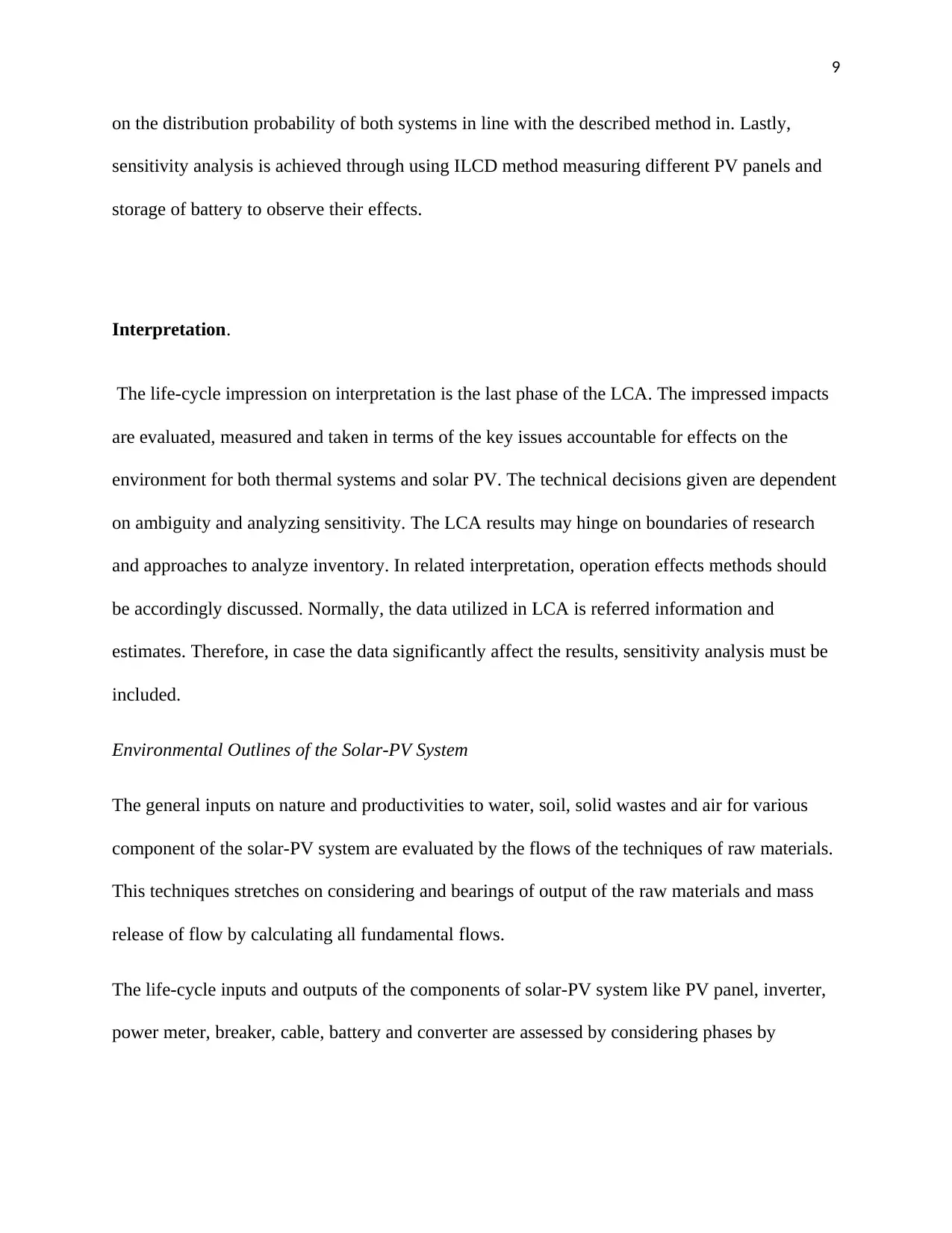
9
on the distribution probability of both systems in line with the described method in. Lastly,
sensitivity analysis is achieved through using ILCD method measuring different PV panels and
storage of battery to observe their effects.
Interpretation.
The life-cycle impression on interpretation is the last phase of the LCA. The impressed impacts
are evaluated, measured and taken in terms of the key issues accountable for effects on the
environment for both thermal systems and solar PV. The technical decisions given are dependent
on ambiguity and analyzing sensitivity. The LCA results may hinge on boundaries of research
and approaches to analyze inventory. In related interpretation, operation effects methods should
be accordingly discussed. Normally, the data utilized in LCA is referred information and
estimates. Therefore, in case the data significantly affect the results, sensitivity analysis must be
included.
Environmental Outlines of the Solar-PV System
The general inputs on nature and productivities to water, soil, solid wastes and air for various
component of the solar-PV system are evaluated by the flows of the techniques of raw materials.
This techniques stretches on considering and bearings of output of the raw materials and mass
release of flow by calculating all fundamental flows.
The life-cycle inputs and outputs of the components of solar-PV system like PV panel, inverter,
power meter, breaker, cable, battery and converter are assessed by considering phases by
on the distribution probability of both systems in line with the described method in. Lastly,
sensitivity analysis is achieved through using ILCD method measuring different PV panels and
storage of battery to observe their effects.
Interpretation.
The life-cycle impression on interpretation is the last phase of the LCA. The impressed impacts
are evaluated, measured and taken in terms of the key issues accountable for effects on the
environment for both thermal systems and solar PV. The technical decisions given are dependent
on ambiguity and analyzing sensitivity. The LCA results may hinge on boundaries of research
and approaches to analyze inventory. In related interpretation, operation effects methods should
be accordingly discussed. Normally, the data utilized in LCA is referred information and
estimates. Therefore, in case the data significantly affect the results, sensitivity analysis must be
included.
Environmental Outlines of the Solar-PV System
The general inputs on nature and productivities to water, soil, solid wastes and air for various
component of the solar-PV system are evaluated by the flows of the techniques of raw materials.
This techniques stretches on considering and bearings of output of the raw materials and mass
release of flow by calculating all fundamental flows.
The life-cycle inputs and outputs of the components of solar-PV system like PV panel, inverter,
power meter, breaker, cable, battery and converter are assessed by considering phases by
⊘ This is a preview!⊘
Do you want full access?
Subscribe today to unlock all pages.

Trusted by 1+ million students worldwide
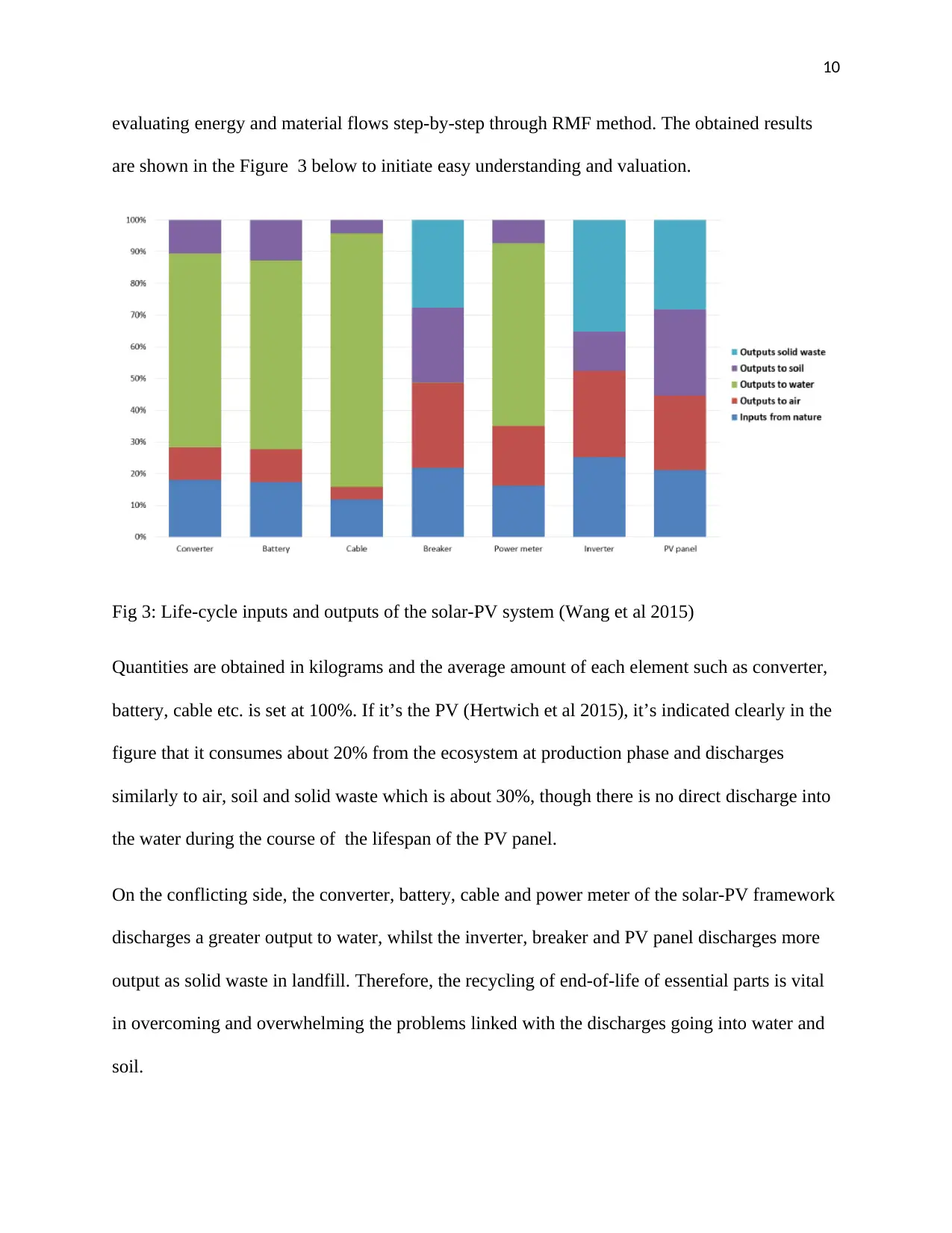
10
evaluating energy and material flows step-by-step through RMF method. The obtained results
are shown in the Figure 3 below to initiate easy understanding and valuation.
Fig 3: Life-cycle inputs and outputs of the solar-PV system (Wang et al 2015)
Quantities are obtained in kilograms and the average amount of each element such as converter,
battery, cable etc. is set at 100%. If it’s the PV (Hertwich et al 2015), it’s indicated clearly in the
figure that it consumes about 20% from the ecosystem at production phase and discharges
similarly to air, soil and solid waste which is about 30%, though there is no direct discharge into
the water during the course of the lifespan of the PV panel.
On the conflicting side, the converter, battery, cable and power meter of the solar-PV framework
discharges a greater output to water, whilst the inverter, breaker and PV panel discharges more
output as solid waste in landfill. Therefore, the recycling of end-of-life of essential parts is vital
in overcoming and overwhelming the problems linked with the discharges going into water and
soil.
evaluating energy and material flows step-by-step through RMF method. The obtained results
are shown in the Figure 3 below to initiate easy understanding and valuation.
Fig 3: Life-cycle inputs and outputs of the solar-PV system (Wang et al 2015)
Quantities are obtained in kilograms and the average amount of each element such as converter,
battery, cable etc. is set at 100%. If it’s the PV (Hertwich et al 2015), it’s indicated clearly in the
figure that it consumes about 20% from the ecosystem at production phase and discharges
similarly to air, soil and solid waste which is about 30%, though there is no direct discharge into
the water during the course of the lifespan of the PV panel.
On the conflicting side, the converter, battery, cable and power meter of the solar-PV framework
discharges a greater output to water, whilst the inverter, breaker and PV panel discharges more
output as solid waste in landfill. Therefore, the recycling of end-of-life of essential parts is vital
in overcoming and overwhelming the problems linked with the discharges going into water and
soil.
Paraphrase This Document
Need a fresh take? Get an instant paraphrase of this document with our AI Paraphraser
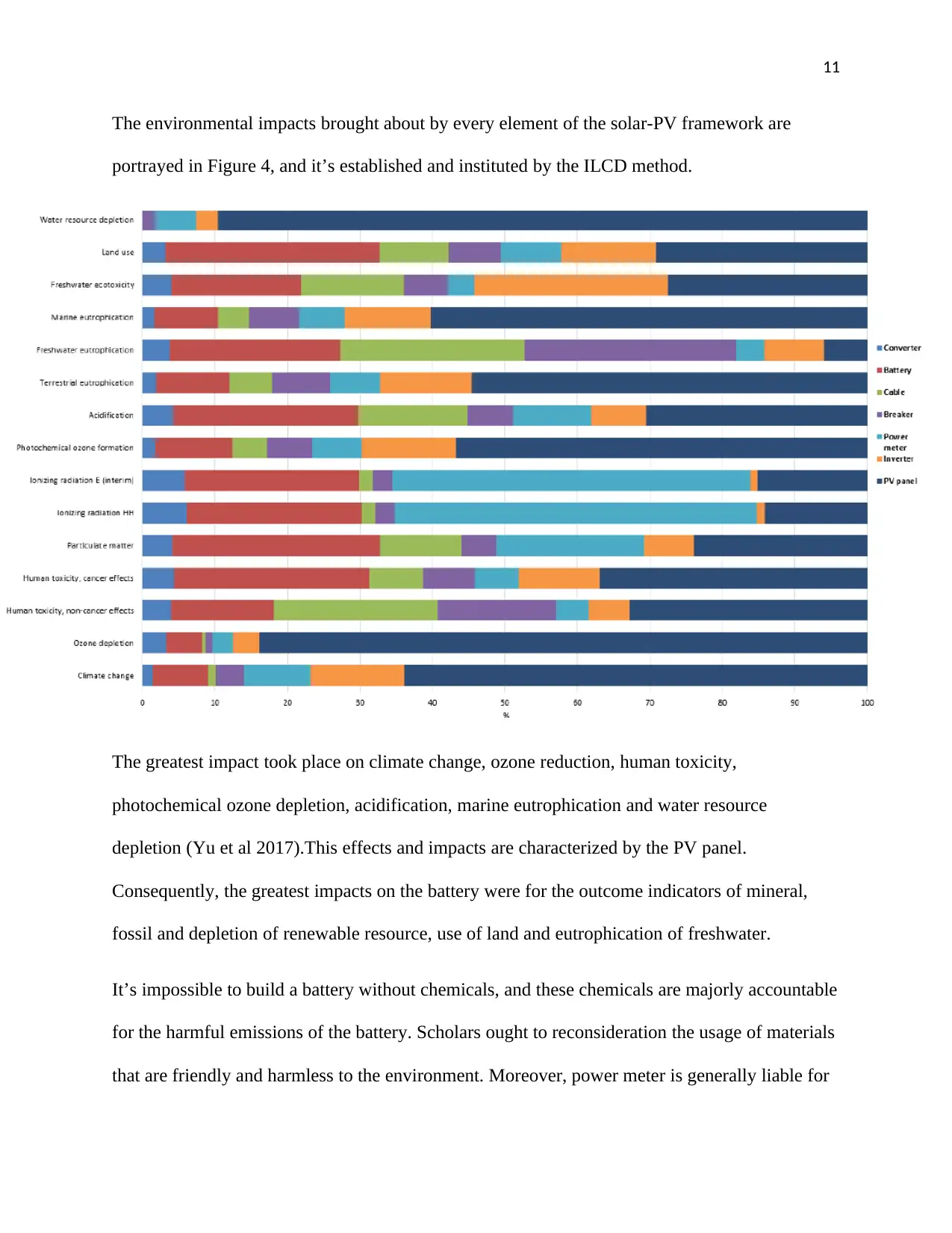
11
The environmental impacts brought about by every element of the solar-PV framework are
portrayed in Figure 4, and it’s established and instituted by the ILCD method.
The greatest impact took place on climate change, ozone reduction, human toxicity,
photochemical ozone depletion, acidification, marine eutrophication and water resource
depletion (Yu et al 2017).This effects and impacts are characterized by the PV panel.
Consequently, the greatest impacts on the battery were for the outcome indicators of mineral,
fossil and depletion of renewable resource, use of land and eutrophication of freshwater.
It’s impossible to build a battery without chemicals, and these chemicals are majorly accountable
for the harmful emissions of the battery. Scholars ought to reconsideration the usage of materials
that are friendly and harmless to the environment. Moreover, power meter is generally liable for
The environmental impacts brought about by every element of the solar-PV framework are
portrayed in Figure 4, and it’s established and instituted by the ILCD method.
The greatest impact took place on climate change, ozone reduction, human toxicity,
photochemical ozone depletion, acidification, marine eutrophication and water resource
depletion (Yu et al 2017).This effects and impacts are characterized by the PV panel.
Consequently, the greatest impacts on the battery were for the outcome indicators of mineral,
fossil and depletion of renewable resource, use of land and eutrophication of freshwater.
It’s impossible to build a battery without chemicals, and these chemicals are majorly accountable
for the harmful emissions of the battery. Scholars ought to reconsideration the usage of materials
that are friendly and harmless to the environment. Moreover, power meter is generally liable for
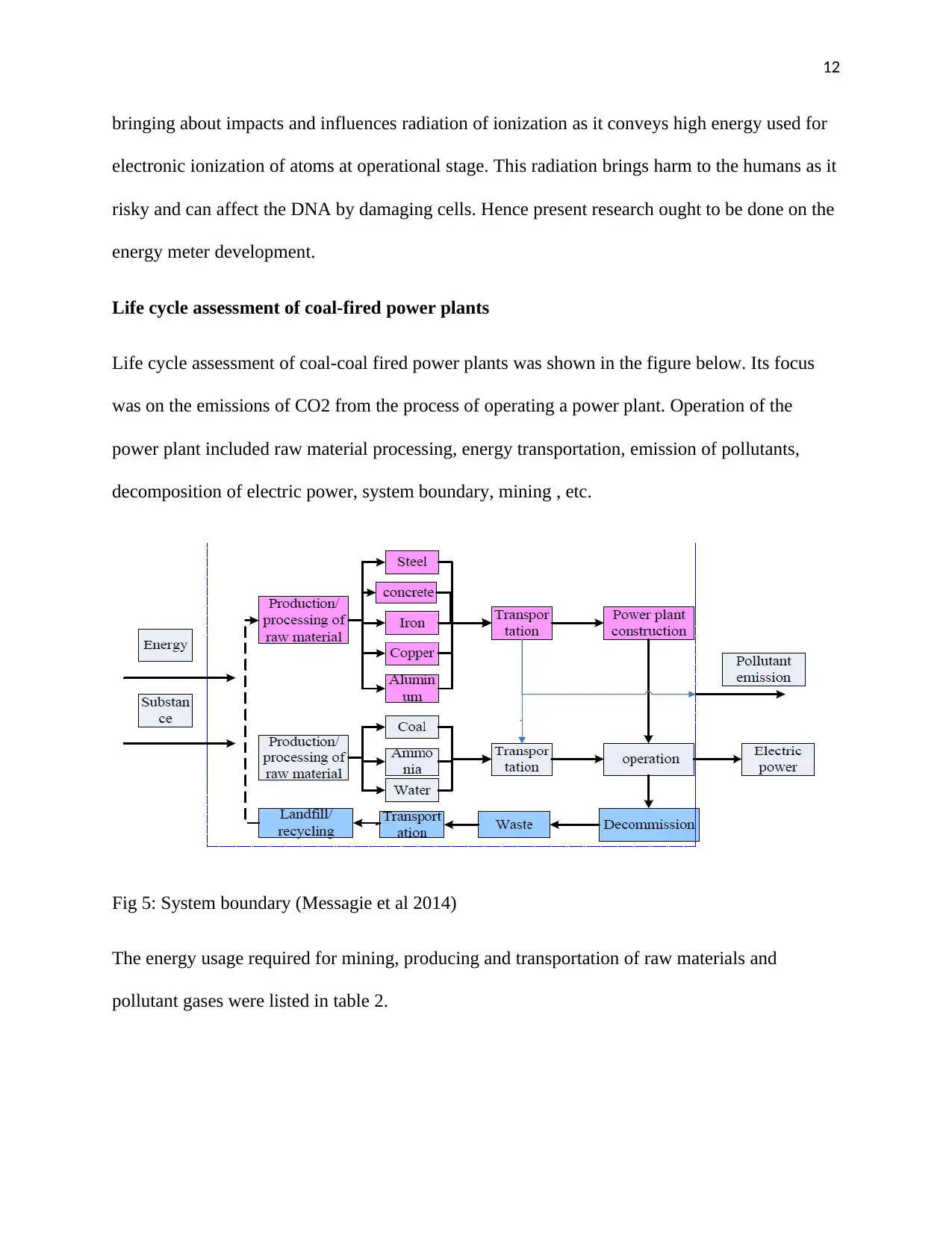
12
bringing about impacts and influences radiation of ionization as it conveys high energy used for
electronic ionization of atoms at operational stage. This radiation brings harm to the humans as it
risky and can affect the DNA by damaging cells. Hence present research ought to be done on the
energy meter development.
Life cycle assessment of coal-fired power plants
Life cycle assessment of coal-coal fired power plants was shown in the figure below. Its focus
was on the emissions of CO2 from the process of operating a power plant. Operation of the
power plant included raw material processing, energy transportation, emission of pollutants,
decomposition of electric power, system boundary, mining , etc.
Fig 5: System boundary (Messagie et al 2014)
The energy usage required for mining, producing and transportation of raw materials and
pollutant gases were listed in table 2.
bringing about impacts and influences radiation of ionization as it conveys high energy used for
electronic ionization of atoms at operational stage. This radiation brings harm to the humans as it
risky and can affect the DNA by damaging cells. Hence present research ought to be done on the
energy meter development.
Life cycle assessment of coal-fired power plants
Life cycle assessment of coal-coal fired power plants was shown in the figure below. Its focus
was on the emissions of CO2 from the process of operating a power plant. Operation of the
power plant included raw material processing, energy transportation, emission of pollutants,
decomposition of electric power, system boundary, mining , etc.
Fig 5: System boundary (Messagie et al 2014)
The energy usage required for mining, producing and transportation of raw materials and
pollutant gases were listed in table 2.
⊘ This is a preview!⊘
Do you want full access?
Subscribe today to unlock all pages.

Trusted by 1+ million students worldwide
1 out of 19
Related Documents
Your All-in-One AI-Powered Toolkit for Academic Success.
+13062052269
info@desklib.com
Available 24*7 on WhatsApp / Email
![[object Object]](/_next/static/media/star-bottom.7253800d.svg)
Unlock your academic potential
Copyright © 2020–2025 A2Z Services. All Rights Reserved. Developed and managed by ZUCOL.





